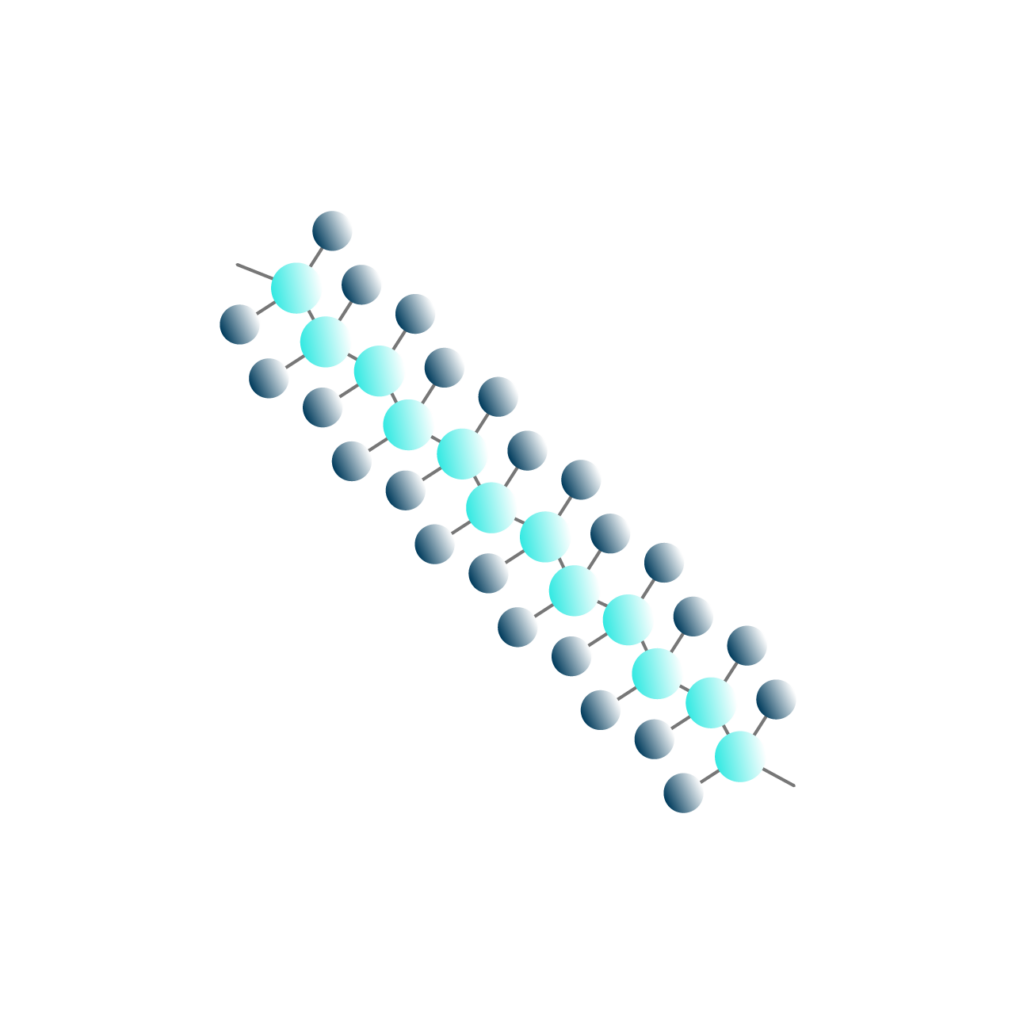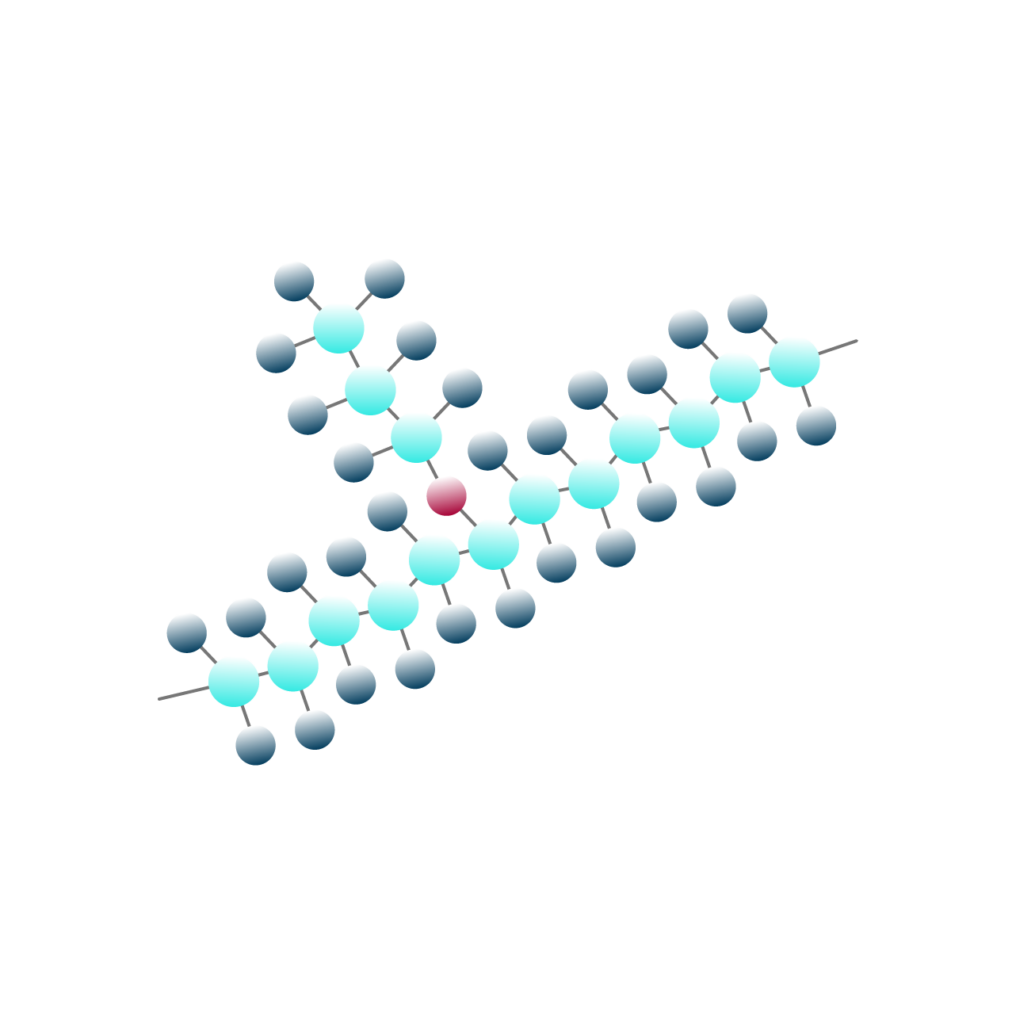Material
Polytetrafluorethylen – PTFE – ist ein Polymerisat aus Tetrafluorethylen. Es handelt sich um einen teilkristallinen Fluorkunststoff mit höchstem Fluorierungsgrad. Bedingt durch die Molekularstrukturen der Fluor- und Kohlenstoffatome bestehen extrem starke Bindungen, woraus eine hohe Stabilität gegen fast alle organischen und anorganischen Chemikalien gegeben ist. Vor allem dies – gepaart mit einem breiten Temperatureinsatzbereich und einem sehr niedrigen Reibungskoeffizienten – hat PTFE zum am häufigsten eingesetzten Fluorkunststoff gemacht. Es ist heutzutage aus den Kernbereichen unserer Wirtschaft nicht mehr wegzudenken.
Dabei basierte die „Entdeckung“ von Polytetrafluorethylen im Jahre 1938 quasi auf einem Zufall: Bei dem Versuch, aus Tetrafluorethylen (TFE) ein geruchloses, unbrennbares und ungiftiges Kältemittel zu synthetisieren, bemerkte der Chemiker Dr. Roy Plunkett (Forschungsgruppe Du Pont) in seinem Reaktionsgefäß ein weißes, wachsartiges Pulver: das Polytetrafluorethylen (PTFE) – als Ergebnis einer Polymerisationsreaktion. Der Grundstein für einen Welterfolg, bekannt geworden unter dem Namen Teflon®, war gelegt.
Virginales PTFE wird in unserem Unternehmen unter dem Namen NUE 1 aufbereitet und weiterverarbeitet.
Charakteristische Eigenschaften sind:
- Temperaturbeständigkeit von -200°C bis +260°C
- hohes elektrisches Isolationsvermögen
niedriger Reibungskoeffizient, ohne Stick-Slip-Effekt - ausgeprägtes antiadhäsives Verhalten
physiologische Unbedenklichkeit (FDA- und BfR-konform) - ausgezeichnete Witterungs- und Alterungsbeständigkeit
- keine Wasseraufnahme
- geringe Wärmeleitfähigkeit
- außerordentlich geringe Neigung zum Brennen (UL 94 (bei 1,5 mm): VO, LOI-Index: 95 %)
- PTFE ist im Vakuum einsetzbar
Bei reinem PTFE ist zu beachten:
- verhältnismäßig geringe Verschleißfestigkeit, bei Bedarf ist der Einsatz von PTFE-Compounds zu prüfen
- hohe Neigung zum Kaltfluß
- geringe Beständigkeit gegen energiereiche Strahlung, ab Strahlungsdosis von 10 kGy Veränderung der Polymereigenschaften
- schlechtes Klebeverhalten
- nicht im Spritzgußverfahren verarbeitbar

Chemisch modifiziertes PTFE – NUE M 1 – erweitert durch einen in die Polymerkette eingelagerten Modifier die positiven Eigenschaften des NUE 1 wesentlich:
- geringere Neigung zum Kaltfluß (Deformation unter Last)
- dichteres, porenärmeres Gefüge
- verbessertes Rückstellverhalten
- verbessertes Schweißverhalten
- glattere Oberflächen und höhere Transparenz
Darüber hinaus erlauben spezielle teilmodifizierte Materialtypen für dynamische Beanspruchungen optimale Bauteilabstimmungen hinsichtlich Druck- und Zeitstandverhalten. Wir beraten sie gern!

PTFE-Compounds entstehen durch das Zumischen von Füllstoffen in das PTFE – Basispolymer. Ziel ist es, dadurch die Werkstoffeigenschaften für spezifische Einsatzanforderungen zu optimieren. Schwerpunktmäßig dienen Füllstoffe zur:
- Reduzierung des Kaltflusses (Deformation unter Last)
- Erhöhung der Verschleißfestigkeit
- Erhöhung der elektrischen Leitfähigkeit und der Wärmeleitfähigkeit und
- Verringerung der Wärmeausdehung
Darüber hinaus ermöglicht das Einbringen von speziellen Pigmenten auch das Einfärben von PTFE-Materialien – zum Beispiel zur optischen Unterscheidung ähnlicher Teile oder als Vermarktungshilfe.
Eigenschaft
Füllstoffe
| GLAS | KOHLE | BRONZE | GRAPHIT | |
| Dichte | • | ⚬ | • | ⚬ |
| Reißfestigkeit | ⚬ | ⚬ | ⚬ | ⚬ |
| Reißdehnung | ⚬ | ⚬ | ⚬ | ⚬ |
| Kugeldruckhärte | • | • | • | • |
| Druckfestigkeit / Deformation unter Last | • | • | • | • |
| Verschleißfestigkeit | • | • | • | • |
| Reibungskoeffizient | • | • | • | • |
| Wärmeausdehnung | ⚬ | ⚬ | ⚬ | ⚬ |
| Temperatur-Einsatzbereich | ⚬ | ⚬ | ⚬ | ⚬ |
| Wärmeleitfähigkeit | ⚬ | • | • | • |
| elektrische Leitfähigkeit | ⚬ | • | • | • |
| elektrische Durchschlagsfestigkeit | ⚬ | ⚬ | ⚬ | ⚬ |
| Porösität | • | • | • | • |
| Chemiekalienbeständigkeit | ⚬ | ⚬ | ⚬ | ⚬ |
| • erhöht | ⚬ reduziert | ⚬ unverändert | ||